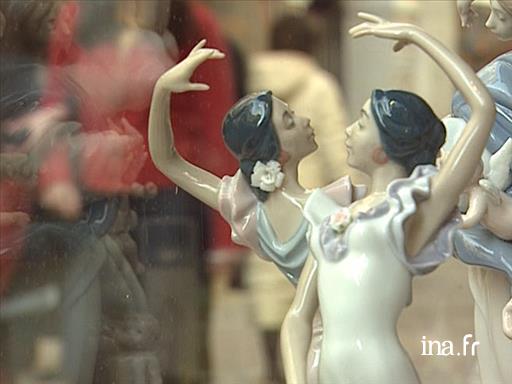
The flamenco dance, made in diversity
The writer and historian José Manuel Gamboa situated the beginnings of flamenco at the time of the French Revolution. Europe was experiencing upheaval; all facets of social life were undergoing change. In Spain, "Kings Charles III (1759-1788) and Charles IV (1789-1808) were aware of the need to modernize the country, not only on an economic and administrative level, but also legally and culturally" [1]. The Pragmatic Sanction published in 1783 granted Gypsies citizen status. However, it also imposed measures to erase any features that distinguished Gypsies from the rest of the Spanish population. This forced acculturation was taken to a new level with the Catholic Kings (1499). It was one of the factors that helped lead to the disappearance of their language; music became a cultural refuge, and according to guitarist Pedro Peña Fernández, music became a language [2].
“For these musicians who had been playing music for generations, what better way to express a shared sentimentality is there than through the language of their music?” Over time, this subliminal language came to represent a kind of code for the link between song and feelings that could be felt during family and collective Réunions. It can therefore be said that when Gypsies sing and dance, they do so for all Gypsies, because they more than anyone else understand their fellow kin. If it is an artist and you put him on the most prestigious stage, he, like anyone else, would endeavor to triumph by pleasing the majority. But in his heart, he would know, and he would be nostalgic for the authentic atmosphere that so easily lent to singing and dancing with his own kin. Because it is with his own kin that song and dance becomes a form of language of the soul. It is a vehicle for sharing profound feelings that enable them to communicate, to understand each other, to feel and to reaffirm their identity and sense of belonging. The musical language of the Gypsies translates these feelings.” [3]
The art of emotion and the link between song and sentiment
This particular approach to sentiment and to the sharing of emotion through music makes flamenco an art of emotion and this link when practised with one’s fellow kin. In this regard, Pedro Peña evokes the special relationship that developed between song and dance in family and collective gypsy celebrations during his childhood in lower Andalusia.
“Song was expressed with force and feeling, so that it moved and motivated anyone present to leave the group to dance in the circle. When some began to form shapes with their hands in the air, transmitting the same message as the song with their bodies, something indescribable would happen. (...) There was a conjunction of dance and song in a most spontaneous and natural way, the song would be visualized through the movements and expressive gestures of the person who was dancing. I (Pedro Peña) understood that we don’t just sing for the dance in our celebrations, but we actually dance the song. According to the elders, our real dances take on more meaning if they reach interiority, that is, that one’s gestures and movements express contemplation. It is rare that they are aggressive or that they seek a disproportionate effect. They affect us even more when the movements unfold upwards from waist level, focusing mainly on the arms and hands. At least two * > desplantes * > [4]need to be included in each dance. Finally, many are the men and women who sing and dance at the same time. » [5]
This perception of flamenco has been brought to the stage since 1989 in his performances based on the Pinini clan by Pedro Peña’ cousin, Pedro Bacán, a guitarist by profession.
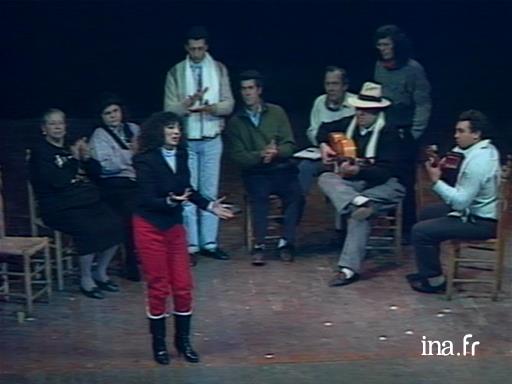
This approach was designed to question the Epinal image of Gypsy flamenco with its exotic overtones, and to restore the art of performing to a musical dimension that depicted emotion stripped of any theatricality. To achieve this, he revised the function of the guitar, which allowed him to rethink the expressive identity of the dance, and to refocus the instrumental and choreographic languages based on song.
Pedro Bacán’s artistic research serves as proof as to the impossibility of defining a single type of flamenco. The research reintroduced room for musical freedom into flamenco: that of improvisation, which was necessary in the past to win a prize or to be listened to by one’s family at a family celebration. It complemented new ways of thinking about flamenco that emerged in the 1970s. In his two discs: *Despegando * and Homenaje a Don Antonio *Chacón * (1977), Enrique Morente shows us that it is not always necessary to imitate traditional models. It becomes a reality as soon as there is a dialogue between the past and the present, between the musical material and its popular and academic, native and foreign sources. The dancers Andrés Marín and Israel Galván succeeding in living up to this challenge in the 1990s.
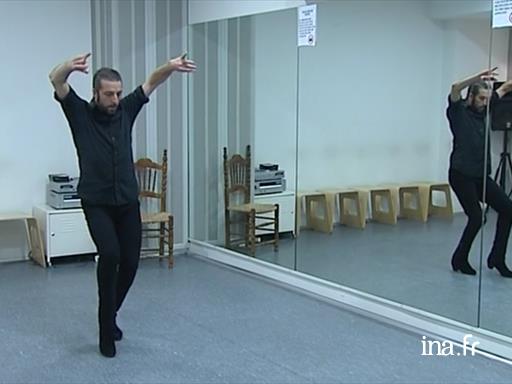
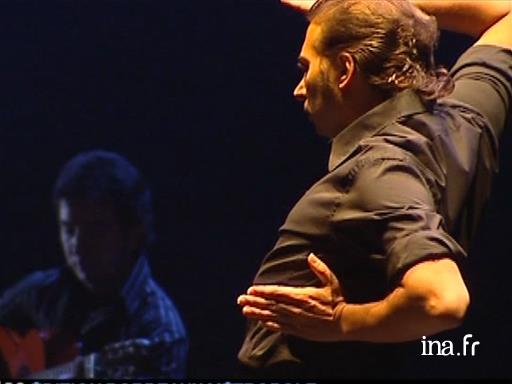
At the crossroads of continents
Flamenco was born from an unlikely mix of influences from Europe, Africa, the East and the New World according to musicologist Faustino Núñez. Central to the early stages of the history of flamenco was a territory limited to Cadiz and its Bay, Seville and Malaga, mostly located in lower Andalusia. The trade between Spain and the Americas was concentrated to the port towns. They attracted a destitute population seeking work who crossed over the borders into Andalusia. The repertoires of flamenco bear witness to this geographical and cultural diversity.
The Royal order of 28th December 1799 brought about a radical change in the show business world of the time: it forbade all actors, dancers and singers who came from other nations from performing. This allowed Spanish dancers, especially Andalusian dancers to dominate. A new repertoire was created: the school of bolera, which stylized popular dances, taking elements from classical dance. At the end of the 1840s, public rehearsals were programmed in the dance academies of Seville. Alongside the “boleras” dancers, gypsy dancers came especially from Triana [6] to attract a an audience that was fond of exoticism and ready to cross the Guadalquivir river to admire them during the dances “del candil” because they danced to the light of oil lamps. New ways of dancing flamenco were created: the jaleos bailes which included vocals and the guitar. In the 1860s, they became the jaleo flamenco [7].
During these years, differentiations were made between styles, some being referred to as “Gypsy style”, then as “flamenco style”, which would explain the name of dances including the terms Gypsy, and then flamenco. They can be placed alongside a budding theatrical tradition in the 16th century, featuring Gypsy performers who sang and danced in the Gypsy style. As José Luis Navarro García [8] points out, the actors called 'comedians' came from the Andalusian working class. However, this profession was frowned upon if you were Andalusian, but was acceptable if you were a Gypsy. Certainly, the fusion of genres is at the origin of flamenco as well as for the flamenco dance. But it would seem that the mixing of styles also had its role to play. The same can be said for the mirror game that was born from the fascination for the Gypsy, who was seen as a figure of musical and dancing alterity.
Seville, important town in Flamenco dance
The city of Seville is part of this process of mixing of styles. During his travels to Andalusia during the 1860s, the writer Charles Davillier noted that each major city possesses its own dance, Cadix has the olé, Jerez the jaleo, Ronda therondeña, and Malaga the malagueña. Seville is "the city where these dances are changed, recomposed and perfected. (...) It is the workshop where old dances are transformed into modern dances; it is the university where the inimitable grace, the irresistible attraction, the delightful attitudes, the brilliant turns and the delicate movements of the Andalusian dance are learnt.” Any new dance from India or America did not became fashionable unless it first passed through this Sevillian school [9]. Seville was still a strong benchmark in the world of flamenco dance at the time of Manuela Vargas who agreed to stage a dance lesson with his master Enrique el Cojo.

Faustino Núñez points out that "the radiance and influence of flamenco was due to the fact that this art was brought into the spotlight thanks to the guitar and to dance" [10]. The history of flamenco is dotted with places that have been marked by the practice of dance:
- the bailes del Candil, which were very popular during the first half of the 19th century, and even in the 1860s,.
- performances organized in dance academies as early as the 1840s,
- the cafés cantantes, a sort of Parisian-style concert-cafés, the first of which was opened in Seville in 1847,
- the theatres that hallowed the age of flamenco ballet from 1915-1925 and the creation of the first Flamenco dances companies,
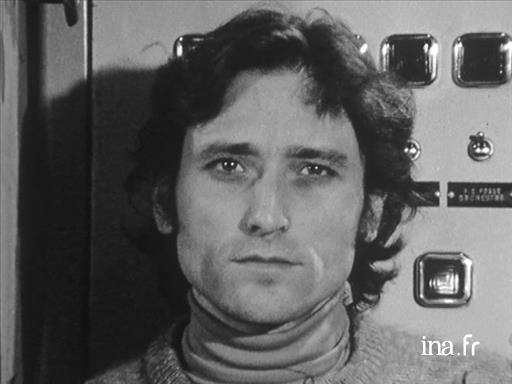
Interview with Antonio Gades and an extract of the flamenco dance
In a bar in Saint Germain des Prés in Paris, an interview with Antonio Gades talking about flamenco, its history, its teaching and the research he is undertaking to help to develop this art. Extract from his show being performed in Paris.
- the creation of a flamenco theatre in 1971.
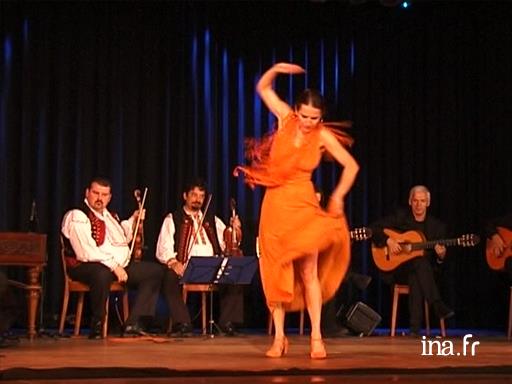
Flamenco, the flame of Spain
Report in Seville. The rebirth of traditional flamenco: an integral part of the culture of the Gypsies, which was banned under the dictatorship of Franco, experienced a revival before only recently becoming a commercial product. Commentary on the images by Paco Lira, owner of the tavern the Carbonería, Bettina Castano, dancer, and Felipe Luis Maestro, director of the International Flamenco fair.
Of all its milestones, the written history of flamenco situates the golden age at the time of the cafés cantantes during the last decades of the 19th century up until 1936. The success of these cafés went far beyond the borders of Andalusia. It was in such cafés, which were exported throughout the whole of Spain, that the musical and choreographic foundations for flamenco were defined. The first flamenco dances were indeed developed there: alegrías, tangos, soleares and zapateados. They lay the groundwork for a male and female aesthetic. Creativity and audacity were needed to stand up to the fierce competition. Flamenco became an art for professionals once and for all. It was created not only based on the image of the other, the Gypsy, in a creative sense of borrowing but also the improvisation needed to invent new styles of dances. In 1912, the Sevillian dance master José Otero condemned a new practice at the end of the 19th century which consisted of creating new repertoires by choreographing more and more Flamenco songs. According to the definition of Faustino Núñez, flamenco would become a mere artistic reinterpretation of the tradition. Alongside this official history of flamenco, another history can be found in the practice of dance itself. This second history asserts an adaptable filiation, specific to oral transmission. It is a history that is much more easily depicted in models we know thanks to filmed accounts including Vicente Escudero, Antonio El Bailarín, Carmen Amaya..., than in performers atcafés cantantes. It now faces a new challenge of flamenco dance, i.e. creation that does not stop at virtuosity.
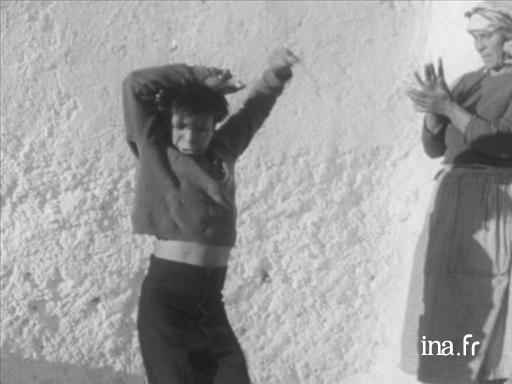
Notes:
[1] TODOROV, Tzvetan, Goya à l'ombre des Lumières, Paris, Flammarion, 2011, p 24.
[2] PEÑA FERNÁNDEZ, Pedro, Los Gitanos flamenco, Séville, Almuzara, 2013, p. 102-103.
Ibid p.3 94.
[4] a “desplante” is an immobile posture used as a challenge or a suspension of time, to conclude part of a dance.
[5] PEÑA FERNÁNDEZ, Pedro, op. cit., p. 22-23.
[6] For a long time, Triana was the working-class neighbourhood of Seville with the largest population of gypsies. It is located on the river island of the Cartuja.
[7] NAVARRO García, José Luis, Historia del baile flamenco. Vol 1., Seville, Signatura Ediciones, 2008, p. 256
[8] ibid., p 40. A cómico is a versatile artist who is especially skillful in song and dance.
[9] DAVILLIER (Gustave), Voyage en Espagne, Paris, pre-original edition Hachette, 1873. Instalment from the journal Le Tour du monde. Nouveau journal des voyages, directed by Edouard Charton., n° 365, December 1866, p. 414 [it is a complete work in 41 instalments from the magazine Le Tour du monde. Nouveau journal des voyages directed by Edouard Charton, Paris, édition Hachette, November 1862- June 1873, 640 p and 328 engravings by Gustave Doré.]
[10] Núñez, Faustino, El reloj atrasa nunca than. Las habaneras a los tangos flamencos, conference during the III Ciclo Catalunya Arte Flamenco.





